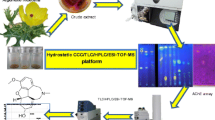Abstract
As over 70% of pharmaceutical compounds are bases, the analysis of these basic compounds by high performance liquid chromatography (HPLC) continues to be of great value and interesting. Acetyl cholinesterase inhibitors (AChEIs), which contain the basic compounds like Rivastigmine tartrate, Galantamine hydrobromide and Donepezil with different polarities, were chosen for the study. A rapid screening of the volatile ion-pairing reagents was performed using modern techniques like ultra high performance liquid chromatography (UHPLC). The experiments were planned using the ‘Design of Experiments’ (DoE) approach to identify the LC–MS compatible ion-pair reagent. In this study, Heptafluorobutyric acid (HFBA) has given a very good peak shape with tailing factor at 1.4 and theoretical plates up to ~5,000 were observed, compared to tailing factor at 1.9 and theoretical plates up to ~3,000 with non-volatile ion-pair reagent sodium heptane sulphonate (SHS). Similarly retention with HFBA was optimum as ~5 min in short run time method compared to ~13 min with SHS. This ion-pair reagent has proved to be good replacement of sodium alkyl sulphonate modifiers. HFBA can also be used for semi-preparative work for isolation of impurities by just evaporating the solvents. It avoids the extraction of other inorganic modifiers.






Similar content being viewed by others
References
Lleó A (2007) Current therapeutic options for Alzheimer’s disease. Curr Genomics 8(8):550–558. doi:10.2174/138920207783769549
Doody RS, Stevens JC, Beck C, Dubinsky RM, Kaye JA, Gwyther L, Mohs RC, Thal LJ, Whitehouse PJ, DeKosky ST, Cummings JL (2001) Practice parameter—management of dementia (an evidence-based review). Report of the Quality Standards Subcommittee of the American Academy of Neurology. Neurology 56(9):1154–1166
Mohs RC, Doody RS, Morris JC, Ieni JR, Rogers SL, Perdomo CA, Pratt RD (2001) A 1-year placebo-controlled preservation of function survival study of donepezil in AD patients. Neurology 57(3):481–488
Geldmacher DS, Provenzano G, McRae T, Mastey V, Ieni JR (2003) Donepezil is associated with delayed nursing home placement in patients with Alzheimer’s disease. J Am Geriatr Soc 51(7):937–944
Feldman H, Gauthier S, Hecker J, Vellas B, Emir B, Mastey V, Subbiah P (2003) Efficacy of donepezil on maintenance of activities of daily living in patients with moderate to severe Alzheimer’s disease and the effect on caregiver burden. J Am Geriatr Soc 51(6):737–744
Sano M, Wilcock GK, van Baelen B, Kavanagh S (2003) The effects of galantamine treatment on caregiver time in Alzheimer’s disease. Int J Geriatr Psychiatry 18(10):942–950
Tiseo PJ, Perdomo CA, Friedhoff LT (1998) Metabolism and elimination of 14C-donepezil in healthy volunteers: a single-dose study. Br J Clin Pharmacol 46(Suppl.1):19–24
Sangshetti JN, Mahaparale PR, Paramane S, Shinde DB (2008) Spectrophotometric estimation of donepezil hydrochloride in bulk and tablet formulation. Trends Appl Sci Res 3:109–112. doi:10.3923/tasr.2008.109.112
Nakashima K, Itoh K, Kono M, Nakashima MN, Wada M et al (2006) J Pharm Biomed Anal 41(1):201–206. doi:10.1016/j.jpba.2005.10.017
Rao BM, Srinivasu MK, Kumar KP, Bharadwaj N, Ravi R, Mohakhud PK, Reddy GO, Kumar PR et al (2005) J Pharm Biomed Anal 37(1):57–63. doi:10.1016/j.jpba.2004.09.041
Shah HJ, Kundlik ML, Pandya A, Prajapati S, Subbaiah G, Patel CN, Patel DM, Suhagiya BN et al (2009) Biomed Chromatogr 23(2):141–151. doi:10.1002/bmc.1095
Krishna Reddy KVSR, Babu JM, Mathad VT, Eswaraiah S, Reddy MS, Dubey PK, Vyas K et al (2004) J Pharm Biomed Anal 35(5):1047–1058. doi:10.1016/j.jpba.2004.03.022
Maláková J, Nobilis M, Svoboda Z, Lisa M, Holcapek M, Kvetina J, Klimes J, Palicka V et al (2007) J. Chromatogr. B 853:265–274. doi:10.1016/j.jchromb.2007.03.025
Ravinder V, Ashok S, Prasad AVSS, Balaswamy G, Kumar YR, Bhaskar BV et al (2008) Chromatographia 67(3-4):331–334. doi:10.1365/s10337-007-0484-3
Flieger J (2010) J Chromatogr A 1217(4):540–549. doi:10.1016/j.chroma.2009.11.083
Wren SAC, Tchelitcheff P (2006) J Chromatogr A 1119:140–146. doi:10.1016/j.chroma.2006.02.052
Gavin PF, Olsen BA (2008) J Pharm Biomed Anal 46(3):431–441
International Conference on Harmonization, Tripartite Guideline “Q8: Pharmaceutical Development” (2005):1–8
Bruzzoniti MC, Mentasti E, Sacchero G, Sarzanini C (1996) Retention model for singly and doubly charged analytes in ion-interaction chromatography. J Chromatogr A 728(1):55–65. doi:10.1016/0021-9673(95)01112-9
Glavina LLM, Cantwell FF (1996) Electrical double-layer and the origin of indirect UV detection in liquid chromatography of a cationic sample using a cationic probe. Anal Chem 68(13):2228–2235. doi:10.1021/ac950727j
Walker TA, Pietrzyk DJ (1987) Ion-interaction chromatographic separation of free amino acids. J Liq Chromatogr 10(1):161–174
Bartha A, Vigh G, Stahlberg J (1990) Extension of the electrostatic retention model of reversed-phase ion-pair chromatography to include the simultaneous effects of the organic modifier and the pairing ion. J Chromatogr 506:85–96. doi:10.1016/S0021-9673(01)91569-9
Liu H, Cantwell FF (1991) Electrical double-layer model for sorption of ions on octadecylsilyl bonded phases including the role of residual silanol groups. Anal Chem 63(10):993–1000. doi:10.1021/ac00010a012
Liu H, Cantwell FF (1991) Electrical double-layer model for ion-pair chromatographic retention on octadesylsilyl bonded phases. Anal Chem 63(18):2032–2037. doi:10.1021/ac00018a026
Staahlberg J (1994) Electrostatic retention model for ion-exchange chromatography. Anal Chem 66(4):440–449. doi:10.1021/ac00076a005
Chen J, Weber SG, Glavina LL, Cantwell FF (1993) Electrical double-layer models of ion-modified (ion-pair) reversed-phase liquid chromatography. J Chromatogr A 656(1-2):549–576. doi:10.1016/0021-9673(93)80819-T
Chromatography in the United States Pharmacopoeia (2007). USP 30-NF 25 (621)
LR Snyder, JL Glajch (1989). In: Computer-assisted Method Development for High performance Liquid Chromatography. J. Chromatogr. 485 (2nd edition)
Snyder LR, Dolan JW, Lommen DC (1989) J Chromatogr 485:65
Molnár I (2002) J Chromatogr A 965(1–2):175–194
L Wood, M McBrian (2008) Presentation at the Pittcon 2008, New Orleans
Hewitt EF, Lukulay P, Galushko S (2006) J Chromatogr A 1107(1–2):79–87
Molnár I, Riegar HJ, Monks KE et al (2010) J Chromatogr A 1217:3193–3200. doi:10.1016/j.chroma.2010.02.001
van Leuken RGJ, Kwakenbos GTC, Duchateau ALL (1993) J Chromatogr A 647:131
Acknowledgments
Authors wish to thank management of Dr. Reddy’s organization for supporting this research work. Authors wish to acknowledge the process research group for providing the samples for our research work.
Author information
Authors and Affiliations
Corresponding authors
Rights and permissions
About this article
Cite this article
Deshpande, G.R., Roy, A.K., Rao, N.S. et al. Rapid Screening of Volatile Ion-Pair Reagents Using UHPLC and Robust Analytical Method Development Using DoE for an Acetyl Cholinesterase Inhibitor: Galantamine HBr. Chromatographia 73, 639–648 (2011). https://doi.org/10.1007/s10337-011-1970-1
Received:
Revised:
Accepted:
Published:
Issue Date:
DOI: https://doi.org/10.1007/s10337-011-1970-1




